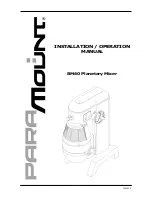
20
4 Controls
4.1
The Fat Channel
StudioLive™ 32.4.2AI
Owner’s Manual
High Pass Filter. Sets the
High-Pass Filter Frequency
Threshold for the Selected
Channel or Output Bus.
The High Pass Filter section
consists of an encoder and
a meter. Frequency range is
indicated to the left of the meter.
The filter’s threshold can be set
from 24 Hz to 1 kHz. When the
meter is set to its lowest point,
the filter is off. The high-pass
filter’s slope is -6 dB/octave.
Power User Tip:
A high-pass
filter attenuates all frequencies
below the set threshold. Use the
Fat Channel high-pass filter to
remove unwanted low-frequencies
from your source signal, rather
than trying to EQ them out.
The high-pass filter is available
on the 32/24/16 channels of the
input bus and on every analog
aux and internal FX bus.
Gate On/Off Button. Turns the
Gate On and Off for the Selected
Channel.
This button engages and
disengages the gate for
the selected channel. It will
illuminate to indicate that
the gate has been enabled.
The gate is available for all
32/24/16 input channels
and every output bus.
Gate Expander Button
(32.4.2AI and 24.4.2AI only).
Turns the Noise Gate into an
Expander.
The StudioLive allows you to
choose between an expander
and a noise gate for each
channel or output. By default, the
Expander button will be enabled.
Power User Tip:
In practice,
expanders and noise gates are
used almost identically. The main
difference is that an expander is
smoother and more gradual, so
that it is easier to set the attack and
release times correctly.
Gate Key Listen Button
(32.4.2AI and 24.4.2AI only).
Enables Key Listen in the Solo Bus.
This button engages and
disengages the Key Listen
function in the solo bus. It
will illuminate to indicate that
the Key Listen is active. When
Key Listen is enabled, and the
selected channel is soloed,
you can use the Control Room
outputs to monitor what the
gate key filter is removing.
Press and hold this button to
set a sidechain to the key filter.
See Section 4.1.4
for details.
Gate Key Filter (32.4.2AI and
24.4.2AI only). Sets and Displays
the Frequency at Which the Gate
Will Open.
This encoder sets, and the meter
displays, the frequency at which
the gate will open. Setting a
specific frequency, in addition
to a specific decibel level,
provides more sonic shaping.
The key filter can be triggered by
the selected channel or bus’s signal
or by sidechaining a channel and
using its signal as the source.
See
Section 4.1.4
for more information
on using a sidechain with the gate.
Power User Tip:
A properly set key
filter on a gate can greatly improve
the overall sound quality of a mix.
For example, if you are inserting
a gate on a snare-drum mic, you
may get enough bleed from the kick
drum to open the gate. This is where
a key filter can come in handy. By
setting the key filter to remove some
of those low frequencies, the gate
won’t be as apt to open for the kick
drum.
















































